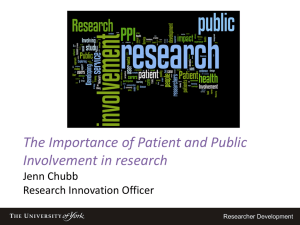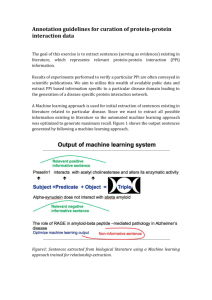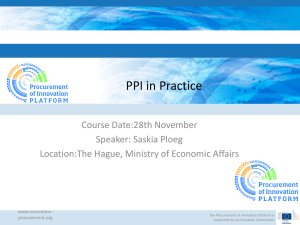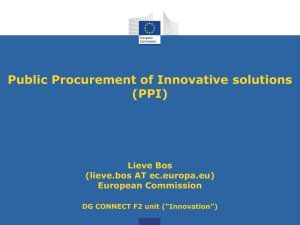Directive 2014/24/EU
advertisement
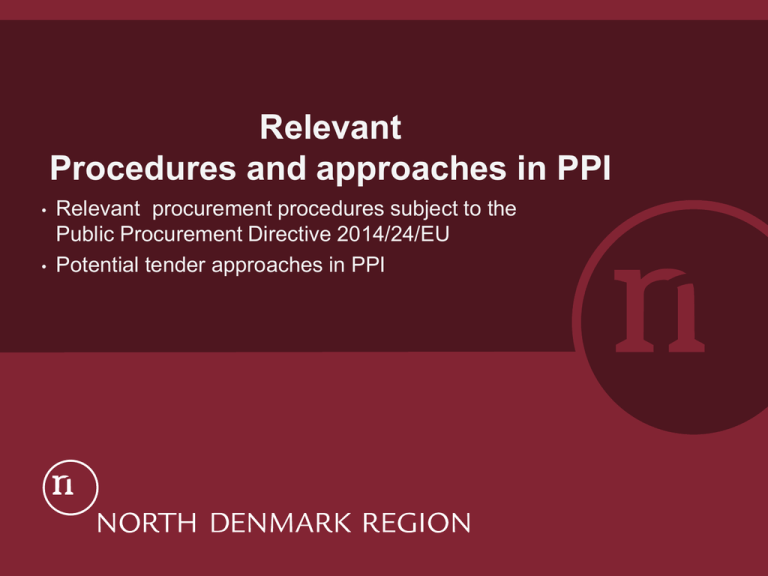
Relevant Procedures and approaches in PPI • • Relevant procurement procedures subject to the Public Procurement Directive 2014/24/EU Potential tender approaches in PPI The Commissions definition of PPI From the FAQ’s on PCP published on the cordis.europa.eu: FAQ no 19: PPI is when contracting authorities, possibly in cooperation with additional private buyers, act as lead customer (also called early adopter or launching customer) by procuring 'innovative’ solutions (not the R&D to develop them) that are newly arriving on the market but that are not yet available on large scale commercial basis due to a lack of market commitment to deploy. A demand-side policy instrument to enhance market penetration speed for ‘innovative solutions’ Everett Roger’s S curve – the tilting 50 % to convince the market How the Commission connects PPI to PCP A definition that • makes PPI a supplement to PCP or other R&D procurements (art. 14 of Directive 2014/24, art. 16 f of the “old” Directive 2004/18/EC • does not directly link PPI to procurement of R&D or mixed procurements of R&D and commercial procurement • makes PPI the ‘Phase 4’ of PCP • makes PPI a policy related instrument with the goal of enhancing deployment of already developed “innovative solutions” The ‘mission-oriented’ definition of PPI From the publication “PPI as Mission-oriented Innovation Policy”, Professor Charles Edquist, Lund University, 2012 PPI occurs when a public organization places an order for the fulfillment of certain functions within a reasonable period of time (through a new product). Hence, the objective (purpose, rationale) of PPI is not primarily to enhance development of new products, but to target functions that satisfy human needs or solve societal problems. ....innovation is needed in all PPI before delivery can take place. In contrast to PPI, regular procurement occurs when public agencies buy ready made products such as pens and paper “off-the-shelf”, where no innovation is involved. A definition that • directly link PPI to procurement of R&D/innovation or mixed procurements of R&D and commercial procurement • presupposes that PPI’s will always relate to “solutions” that is not already on the market and ready to “plug-and-play” • link PPI to (further) demand-side driven innovation in a view to fulfil specific needs ‘Innovation ‘ Directive 2014/24/EU (Procurement directive) Article 2, no. 22 ‘innovation’ means the implementation of a new or significantly improved product, service or process, including but not limited to production, building or construction processes, a new marketing method, or a new organisational method in business practices, workplace organisation or external relations inter alia with the purpose of helping to solve societal challenges or to support the Europe 2020 strategy for smart, sustainable and inclusive growth; ‘Research & Development’ Directive 2009/81/EC (Defence and security directive) Article 1, no. 27: ‘Research and development’ means all activities comprising fundamental research, applied research and experimental development, where the latter may include the realisation of technological demonstrators, i.e., devices that demonstrate the performance of a new concept or a new technology in a relevant or representative environment; See also recital no. 13. ‘Research and innovation projects’ Directive 2014/24/EU (Procurement directive) Article 31 (6) – Innovation partnerships “….research and innovation projects aimed at meeting the needs identified by the contracting authority that cannot be met by existing solutions.” The “common” understanding of PPI • Commercial procurement • Procedures subject to the procurement directives • With the aim of procuring ‘innovative solutions’ or improving or applying/deploying already invented solutions • Might contain R&D, which (seen isolated) could have been procured in accordance with the exemption rules in art. 14 (Dir. 2014/24/EU) or art. 16 f (Dir. 2004/18/EC) Relevant procedures for PPI subject to the Public Procurement Directive 2014/24/EU • In principle – any procedure • The obvious procedures • • • • • Innovation partnership (art. 31) Competitive dialogue (art. 30) Competitive procedure with negotiation (art. 29) Design contest (art. 78) The “light regime” – social services (art. 74) Relevant procedures for PPI subject to the Public Procurement Directive 2014/24/EU The less obvious procedures – but in practice the most utilised (and encouraged) procedures: • Open procedure (art. 27) • Restricted procedure (art. 30) Innovation partnership • “The innovation partnership shall aim at the development of an innovative product, service or works and the subsequent purchase of the resulting supplies, services or works, provided that they correspond to the performance levels and maximum costs agreed between the contracting authorities and the participants.” • The “commercial extension” of PCP Competitive dialogue and competitive procedure with negotiation Article 26 (4) (a) with regard to works, supplies or services fulfilling one or more of the following criteria: (i) the needs of the contracting authority cannot be met without adaptation of readily available solutions; (ii) they include design or innovative solutions; Potential tender approaches in PPI Early announcement Forward Commitment Procurement • Early announcement of intention to procure or the deploy innovative solutions • “Prior information notice” in the OJEU (Official Journal of the European Union) • Between announcement and tender: preliminary market consultation (art. 40) – have the industry solutions reached the required readiness (technology, tests, price?) Early announcement (continued) • Combined with long time limits for the receipt of tenders? • Guarantee of minimum procurement volume? • Notice: Restricted opportunity for dialog during the period from publication of contract notice to time limit for tenders (if open or restricted procedure) Functional requirements • Design the technical specifications with the aim of allowing innovation, efficiency improvement, and new ways of thinking – “open specifications” • Requires focus on the evaluation criteria vs. focus on the (details in the) technical specification • Requires focus on minimum requirements Functional requirements (continued) • Suitable for PPI’s following PCP’s or other Public-PrivateInnovation projects (art. 14/16 f) • Helps to prevent supplier lock-out / disqualifying competitive advantages • Requires focus on the evaluation criteria vs. focus on the technical specification • Requires focus on minimum requirements Variants • Allow the procuring authority to evaluate technical specified solutions and other market “other solutions” • In principal a combined tender with, and without, open (functional) specifications • Requires focus on minimum requirements • Requires very much focus on the evaluation criteria – same evaluation criteria as “normal tender” Total Cost of Ownership (TCO) Life-cycle costing (art. 68) • E.g. energy efficient or labour cost-saving solutions • An evaluation-technical price comprising different aspects of the costs over the life cycle of a product, solution etc. • Focus on data (from the suppliers) and transparent, objectively verifiable and non-discriminatory methods of calculating life-cycle costs • Mandatory legislative EU acts for calculating life-cycle costs shall be applied (updated Annex XIII) Remuneration for participation and shortlisting • Increases the incentives for participating and developing/modifying/adapting solutions • Today: Competitive dialog (and design contest) • Directive 2014/24/EU: + innovation partnership • The same mechanisms as in PCP – competitive development but combined with a public procurement contract Other approaches or tools? • IPR sharing (presupposed in innovation partnership) • Free test sites? • A combination with other policy instruments (subsidies, tax incentives etc.) Always consider the risk of illegal state aid!


